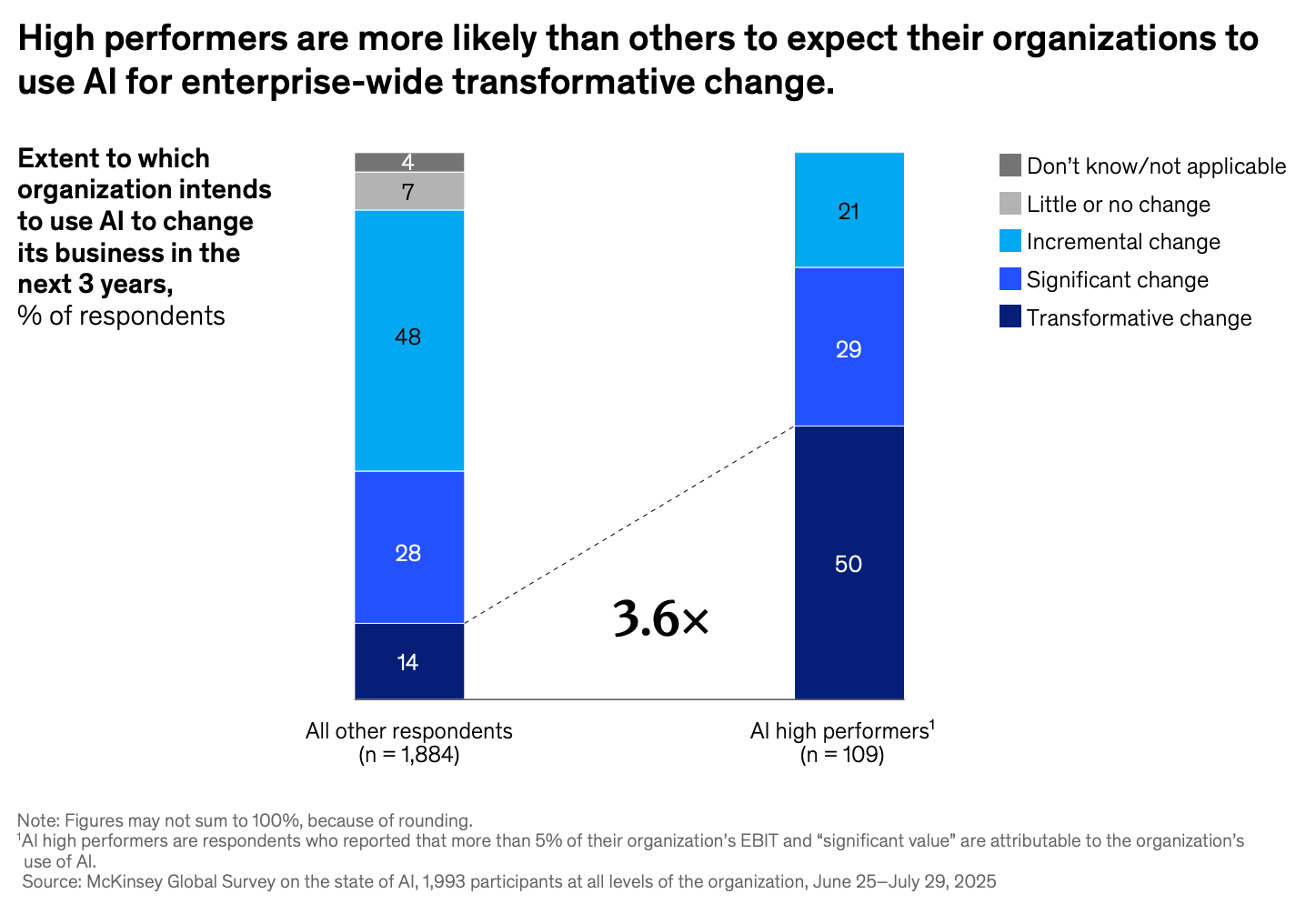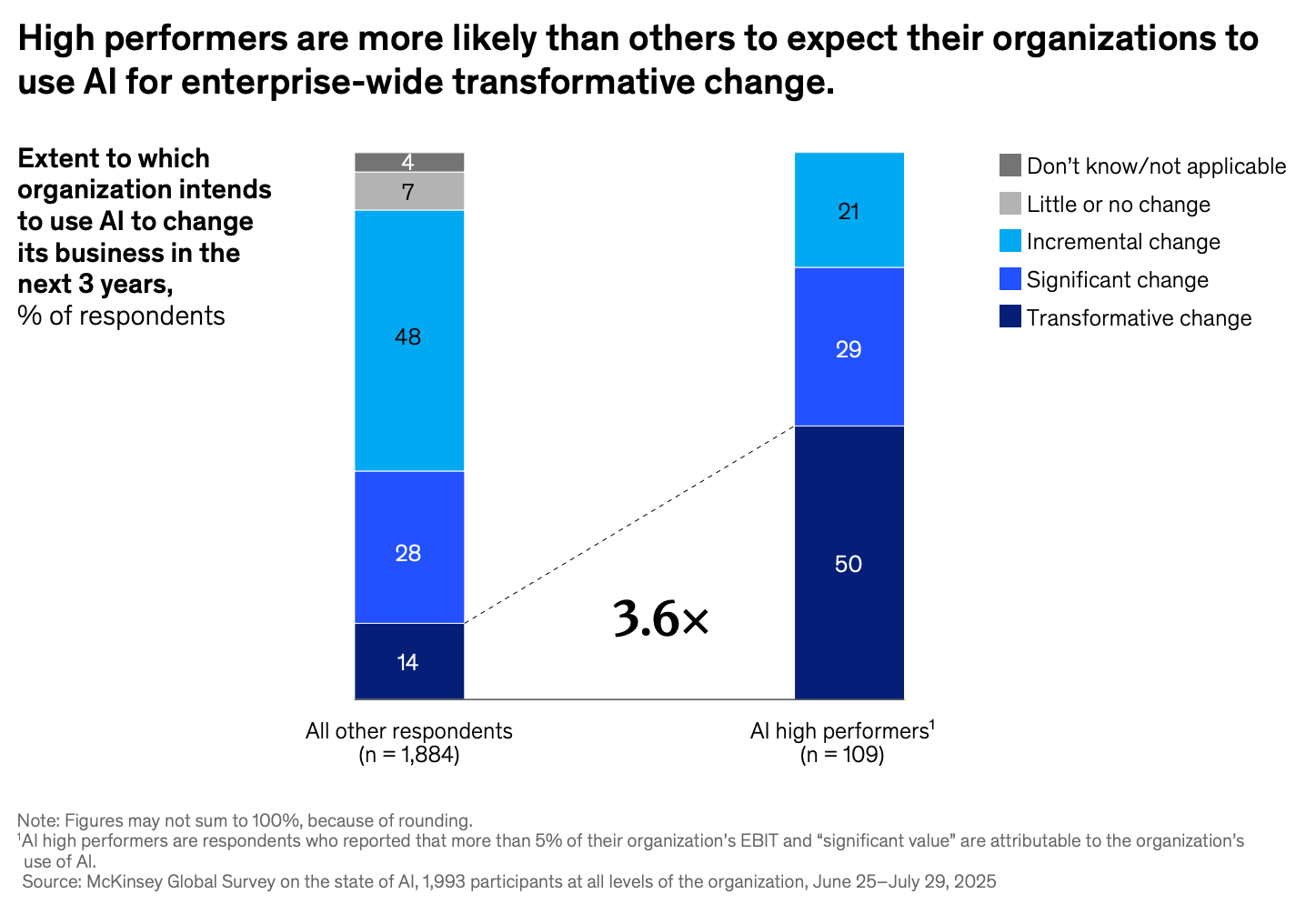The 6% Blueprint: Seven Traits That Separate AI High-Performing Companies from the Rest
Discover the 7 key traits that drive AI high-performers and turn ambition into transformation. Elevate your AI strategy today.
Artificial intelligence has become a defining force of modern business. According to McKinsey’s State of AI 2025 study, one of the most comprehensive examinations of global AI maturity 88% of organizations now report regular AI use in at least one business function. Adoption is widespread, curiosity is strong, and experimentation is everywhere.
But beneath this enthusiasm lies a stark and revealing truth: most companies are not yet realising meaningful value from AI. They’re experimenting, piloting, or testing-but not transforming. The study, which surveyed 1,993 leaders across 105 countries, set out to understand exactly why. Its goal was to identify how AI is being used, where impact is being created, and what separates those capturing value from those falling behind.
The answer lies in a single, powerful insight: only 6% of companies achieve significant, enterprise-level returns from AI. These organisations, labelled AI High Performers are not simply using AI more. They are behaving differently, making bolder choices, and designing their organisations for a future in which AI is embedded at the core of their operations.
This article focuses solely on that top 6%, because their behaviours reveal what’s possible when ambition, leadership, and disciplined execution align.
7 Traits of AI High Performers
Before we explore each trait in detail, it’s important to recognise that these behaviours are not accidents. They are intentional choices that shape how High Performers approach AI. In the sections that follow, we examine the seven characteristics that set these organisations apart and what they mean for any leader ready to elevate their AI strategy.
1. They Aim for Transformation, Not Incremental Efficiency
Most companies approach AI with modest goals: improve a workflow, automate a few tasks, or reduce small percentages of cost. High Performers take a radically different approach. They pursue transformation. They look at AI not as a tool for tweaking the edges of the business but as a catalyst for reimagining it entirely.
The data is clear: High Performers are 3.6× more likely to target significant, enterprise-wide transformation. This ambition acts as an accelerant. It shapes priorities, focuses investment, and inspires teams. It becomes a forcing mechanism that pulls the organisation toward a more innovative future.
2. They Redesign Workflows End-to-End
Where most organisations attempt to insert AI into existing processes, High Performers rebuild the processes themselves. They recognise that AI cannot deliver transformative impact if it is layered on top of outdated, inefficient, or overly complex workflows.
This group is nearly 3× more likely to fundamentally redesign the way work gets done. They construct new workflows where AI and humans interact seamlessly, where value is maximised, and where inefficiencies are eliminated rather than inherited.
Workflow redesign is one of the strongest predictors of value in the entire study. It’s not about adding AI-it’s about designing the business around it.
3. Their Leaders Personally Own the AI Agenda
In most companies, AI lives inside IT, strategy, or digital teams. But in High Performer organisations, AI is a leadership priority. Senior leaders don’t delegate AI-they embody it.
These leaders are 3× more likely to champion AI initiatives, model its usage, and invest consistently. They set the tone, create urgency, and reinforce AI as a strategic enabler rather than a technical curiosity. When leaders lean in, teams follow. When leaders hesitate, the organisation stalls.
Leadership ownership is one of the clearest signals of future AI success.
4. They Scale AI and Agentic Systems Across Functions
While most organisations conduct pilots, High Performers scale. They move quickly from experimentation to enterprise-wide deployment, integrating AI across multiple business functions.
They are at least 3× more likely to be scaling AI agents across areas like finance, operations, product development, and marketing-far beyond the <10% adoption levels seen in general industry. This commitment to scale allows them to capture compounding returns that pilot-bound organisations never experience.
Scaling isn’t a technical challenge; it’s an organisational discipline. High Performers excel at both.
5. They Industrialise Human-in-the-Loop
High Performers recognise that humans play a critical role in AI accuracy, trust, and decision-making. But rather than relying on informal oversight, they build structured, disciplined human-in-the-loop systems.
They define where human judgment is essential, establish validation checkpoints, and bake governance into the workflow. This clarity accelerates adoption by reducing uncertainty and establishing trust.
Human-in-the-loop is not a barrier to AI-it is the mechanism that enables safe, scalable AI.
6. They Invest Like AI Is a Strategic Priority
High Performers invest at levels that reflect their ambitions. One-third of them spend more than 20% of their total digital budgets on AI-compared with only 7% of others. This investment fuels the foundations that matter: high-quality data infrastructure, agile development, reusable data products, and strong cross-functional talent.
Their investment signals commitment. It tells their organisation that AI is not a side project; it is the future.
7. They Accept Risk Because They Operate Where Value Is Real
Interestingly, High Performers experience more negative AI consequences than others-accuracy issues, compliance challenges, and unexpected outputs. But there’s a simple reason: they are applying AI in areas where real impact is created.
They move fast, experiment aggressively, and learn quickly. They understand that risk is not something to be avoided but managed. And because they push AI into mission-critical contexts, they discover challenges earlier and resolve them sooner.
Where others see risk as a barrier, High Performers see it as part of innovation.
Download The 6% Advantage: A Leader’s Checklist for AI Success
AI Success Is a Choice
Every organisation today faces a crossroads. You can pursue AI as a series of small, incremental steps-or as a strategic transformation. You can play it safe and stay in the 94%-or make different choices and join the 6%.
AI success is not predetermined. It is not a product of industry, budget, or geography. It is a function of ambition, openness, experimentation, and the willingness to accept that progress often includes missteps.
The organisations that succeed with AI are not the ones who avoid failure. They are the ones who learn from it. They iterate, test, redesign, and commit to bold visions that extend beyond short-term wins.
The future is being built by those willing to act decisively. The question now is simple:
Do you want to be part of the 6% and if so, what will your next move be?






